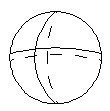< Page 6 of 10 >
1 2 3 4 5 6 7 8 9 10
Astigmatism
Stabilization Techniques for Toric Contact Lenses
Many of the techniques used for stabilizing toric contact lenses are also used for the stabilization of segment style multifocal lenses. In either case, for obvious reasons, lens rotation on the eye needs to be minimized.
Prism Ballast:
This is one of the most common stabilizing techniques. A prism of between
1.00 to 1.50 D is ground base down into the lens. However, greater amounts
of prism may be needed for patients with particularly tight lids, flat
corneas, or oblique axis astigmatism. The lens will tend to rotate so
that the base of the prism is oriented inferiorly. The added thickness
of the lens along the prism base can reduce oxygen permeability through
that portion of the lens resulting in possible hypoxic disturbances
in the inferior zone of the cornea.
|
Prism Ballast |
Truncation: When a lens is truncated, a portion of it is sectioned off. It is usually 0.50 to 1.5 mm on the lower edge of the lens. The amount sectioned off will depend on the size of the lens; larger lenses require greater amounts than smaller lenses. Occasionally the upper edge is sectioned off as well resulting in a double truncated lens. The truncation will serve to stabilize a lens when the lower flat edge comes to lie adjacent to the lower eyelid margin. Truncation is often combined with prism ballast. When a lens is truncated its diameter is effectively reduced which results in a looser fit. To compensate for this the base curves of truncated lenses are generally made somewhat steeper.
|
|
Double Slab-off lenses: This technique creates a lens which is thicker along its central body which lies along the palpebral fissure and thinner along the inferior and superior edges which come to lie under the upper and lower lids. This technique is comfortable since there is no lid impact along the inferior surface. However it does not offer as much lens stability as the truncated or posterior toric techniques. Double slab-off lenses are often combined with a prism ballast to help prevent rotation.
 Double Slab Off |
Posterior Toric Lenses: A back toric surface can be used as a lens stabilizing technique. When the shape of the posterior contact lens surface closely parallels that of the cornea lens rotation can be minimized.
Aspheric Lens Surface: An aspheric surface can aid in lens-axis stabilization by adding drag to the motion of the lens. It is generally used in combination with truncation or prism ballast since it is only minimally effective by itself.
< Page 6 of 10 >
1 2 3 4 5 6 7 8 9 10
